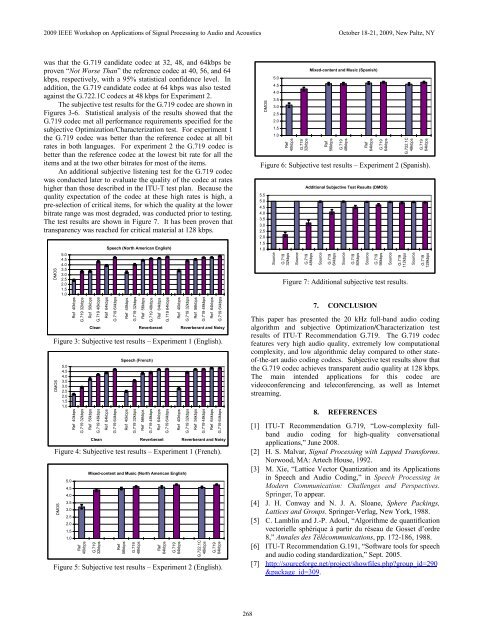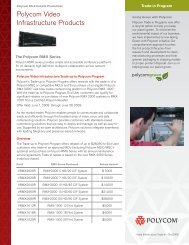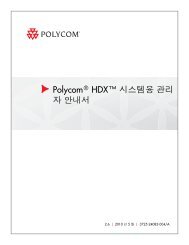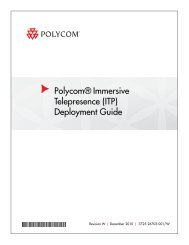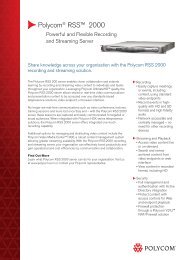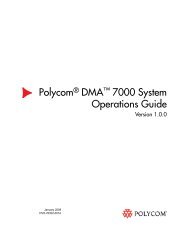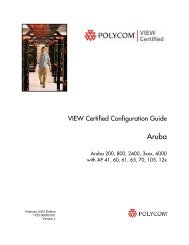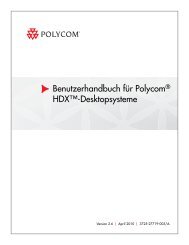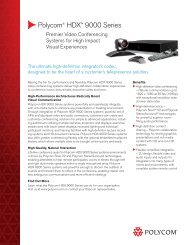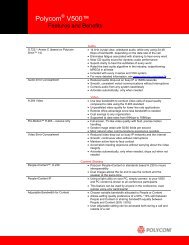ITU-T G.719: A New Low-Complexity Full-Band (20KHZ ... - Polycom
ITU-T G.719: A New Low-Complexity Full-Band (20KHZ ... - Polycom
ITU-T G.719: A New Low-Complexity Full-Band (20KHZ ... - Polycom
Create successful ePaper yourself
Turn your PDF publications into a flip-book with our unique Google optimized e-Paper software.
2009 IEEE Workshop on Applications of Signal Processing to Audio and Acoustics October 18-21, 2009, <strong>New</strong> Paltz, NY<br />
was that the <strong>G.719</strong> candidate codec at 32, 48, and 64kbps be<br />
proven “Not Worse Than” the reference codec at 40, 56, and 64<br />
kbps, respectively, with a 95% statistical confidence level. In<br />
addition, the <strong>G.719</strong> candidate codec at 64 kbps was also tested<br />
against the G.722.1C codecs at 48 kbps for Experiment 2.<br />
The subjective test results for the <strong>G.719</strong> codec are shown in<br />
Figures 3-6. Statistical analysis of the results showed that the<br />
<strong>G.719</strong> codec met all performance requirements specified for the<br />
subjective Optimization/Characterization test. For experiment 1<br />
the <strong>G.719</strong> codec was better than the reference codec at all bit<br />
rates in both languages. For experiment 2 the <strong>G.719</strong> codec is<br />
better than the reference codec at the lowest bit rate for all the<br />
items and at the two other bitrates for most of the items.<br />
An additional subjective listening test for the <strong>G.719</strong> codec<br />
was conducted later to evaluate the quality of the codec at rates<br />
higher than those described in the <strong>ITU</strong>-T test plan. Because the<br />
quality expectation of the codec at these high rates is high, a<br />
pre-selection of critical items, for which the quality at the lower<br />
bitrate range was most degraded, was conducted prior to testing.<br />
The test results are shown in Figure 7. It has been proven that<br />
transparency was reached for critical material at 128 kbps.<br />
DMOS<br />
5.0<br />
4.5<br />
4.0<br />
3.5<br />
3.0<br />
2.5<br />
2.0<br />
1.5<br />
1.0<br />
Ref 40kbps<br />
<strong>G.719</strong> 32kbps<br />
Ref 56kbps<br />
<strong>G.719</strong> 48kbps<br />
Ref 64kbps<br />
Speech (North American English)<br />
<strong>G.719</strong> 64kbps<br />
Ref 40kbps<br />
<strong>G.719</strong> 32kbps<br />
Ref 56kbps<br />
<strong>G.719</strong> 48kbps<br />
Ref 64kbps<br />
Clean Reverberant Reverberant and Noisy<br />
Figure 3: Subjective test results – Experiment 1 (English).<br />
DMOS<br />
5.0<br />
4.5<br />
4.0<br />
3.5<br />
3.0<br />
2.5<br />
2.0<br />
1.5<br />
1.0<br />
Ref 40kbps<br />
<strong>G.719</strong> 32kbps<br />
Ref 56kbps<br />
<strong>G.719</strong> 48kbps<br />
Ref 64kbps<br />
<strong>G.719</strong> 64kbps<br />
Speech (French)<br />
Ref 40kbps<br />
<strong>G.719</strong> 32kbps<br />
Ref 56kbps<br />
<strong>G.719</strong> 48kbps<br />
Ref 64kbps<br />
Clean Reverberant Reverberant and Noisy<br />
Figure 4: Subjective test results – Experiment 1 (French).<br />
DMOS<br />
5.0<br />
4.5<br />
4.0<br />
3.5<br />
3.0<br />
2.5<br />
2.0<br />
1.5<br />
1.0<br />
Ref<br />
40kbps<br />
<strong>G.719</strong> 64kbps<br />
<strong>G.719</strong> 64kbps<br />
Ref 40kbps<br />
Ref 40kbps<br />
Mixed-content and Music (North American English)<br />
<strong>G.719</strong><br />
32kbps<br />
Ref<br />
56kbps<br />
<strong>G.719</strong><br />
48kbps<br />
Ref<br />
64kbps<br />
<strong>G.719</strong><br />
64kbps<br />
<strong>G.719</strong> 32kbps<br />
<strong>G.719</strong> 32kbps<br />
Ref 56kbps<br />
Ref 56kbps<br />
<strong>G.719</strong> 48kbps<br />
<strong>G.719</strong> 48kbps<br />
G.722.1C<br />
48kbps<br />
Ref 64kbps<br />
Ref 64kbps<br />
<strong>G.719</strong> 64kbps<br />
<strong>G.719</strong> 64kbps<br />
<strong>G.719</strong><br />
64kbps<br />
Figure 5: Subjective test results – Experiment 2 (English).<br />
268<br />
DMOS<br />
5.0<br />
4.5<br />
4.0<br />
3.5<br />
3.0<br />
2.5<br />
2.0<br />
1.5<br />
1.0<br />
Ref<br />
40kbps<br />
<strong>G.719</strong><br />
32kbps<br />
Mixed-content and Music (Spanish)<br />
Ref<br />
56kbps<br />
<strong>G.719</strong><br />
48kbps<br />
Ref<br />
64kbps<br />
<strong>G.719</strong><br />
64kbps<br />
G.722.1C<br />
48kbps<br />
<strong>G.719</strong><br />
64kbps<br />
Figure 6: Subjective test results – Experiment 2 (Spanish).<br />
5.5<br />
5.0<br />
4.5<br />
4.0<br />
3.5<br />
3.0<br />
2.5<br />
2.0<br />
1.5<br />
1.0<br />
Source<br />
<strong>G.719</strong><br />
32kbps<br />
Source<br />
Additional Subjective Test Results (DMOS)<br />
<strong>G.719</strong><br />
48kbps<br />
Source<br />
<strong>G.719</strong><br />
64kbps<br />
Source<br />
<strong>G.719</strong><br />
80kbps<br />
Source<br />
<strong>G.719</strong><br />
96kbps<br />
Source<br />
<strong>G.719</strong><br />
112kbps<br />
Figure 7: Additional subjective test results.<br />
7. CONCLUSION<br />
This paper has presented the 20 kHz full-band audio coding<br />
algorithm and subjective Optimization/Characterization test<br />
results of <strong>ITU</strong>-T Recommendation <strong>G.719</strong>. The <strong>G.719</strong> codec<br />
features very high audio quality, extremely low computational<br />
complexity, and low algorithmic delay compared to other stateof-the-art<br />
audio coding codecs. Subjective test results show that<br />
the <strong>G.719</strong> codec achieves transparent audio quality at 128 kbps.<br />
The main intended applications for this codec are<br />
videoconferencing and teleconferencing, as well as Internet<br />
streaming.<br />
8. REFERENCES<br />
[1] <strong>ITU</strong>-T Recommendation <strong>G.719</strong>, “<strong>Low</strong>-complexity fullband<br />
audio coding for high-quality conversational<br />
applications,” June 2008.<br />
[2] H. S. Malvar, Signal Processing with Lapped Transforms.<br />
Norwood, MA: Artech House, 1992.<br />
[3] M. Xie, “Lattice Vector Quantization and its Applications<br />
in Speech and Audio Coding,” in Speech Processing in<br />
Modern Communication: Challenges and Perspectives.<br />
Springer, To appear.<br />
[4] J. H. Conway and N. J. A. Sloane, Sphere Packings,<br />
Lattices and Groups. Springer-Verlag, <strong>New</strong> York, 1988.<br />
[5] C. Lamblin and J.-P. Adoul, “Algorithme de quantification<br />
vectorielle sphérique à partir du réseau de Gosset d’ordre<br />
8,” Annales des Télécommunications, pp. 172-186, 1988.<br />
[6] <strong>ITU</strong>-T Recommendation G.191, “Software tools for speech<br />
and audio coding standardization,” Sept. 2005.<br />
[7] http://sourceforge.net/project/showfiles.php?group_id=290<br />
&package_id=309.<br />
Source<br />
<strong>G.719</strong><br />
128kbps


